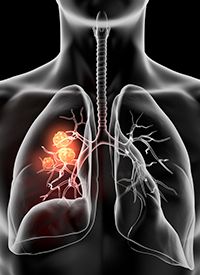TDM-1/Osimertinib Combo Has Limited Efficacy for Resistant EGFR+ NSCLC
The combination of ado-trastuzumab emtansine and osimertinib demonstrated minimal antitumor effects on patients with EGFR-mutated non–small cell lung cancer, according to interim data of the phase 2 TRAEMOS trial.

The combination of ado-trastuzumab emtansine (Kadcyla; T-DM1) and osimertinib (Tagrisso) demonstrated minimal antitumor effects on patients with EGFR-mutated non–small cell lung cancer (NSCLC), according to interim data of the phase 2 TRAEMOS trial (NCT03784599) presented during the International Association for the Study of Lung Cancer (IASLC) 2021 World Lung Cancer Conference.1
Findings showed that the combination induced an overall response rate (ORR) of 11% (n = 3/27) with a disease control rate (DCR) of 48% (n = 13/27) after 12 weeks. The median progression-free survival (PFS) for patients treated with the antibody-drug conjugate (ADC)/TKI regimen was 2.7 months (95% CI, 2.1-3.5).
Lead author Merel Jebbink, MD, of the Department of Thoracic Oncology at the Netherlands Cancer Institute in Amsterdam, the Netherlands, added that investigators observed no meaningful differences between the HER2 IHC 2+ and HER2 IHC 3+ groups for ORR (17% vs 7%, respectively) or DCR (42% vs 53%).
“This treatment strategy shows very limited efficacy,” said Jebbink in a virtual presentation of the findings. “Further clinical evaluation of this regimen is therefore not warranted.”
Resistance to EGFR TKIs develops in all patients with EGFR-mutant NSCLC, and the HER2 bypass track resistance occurs in approximately 15% of cases.
Investigators pursued this combination based on prior results from a single-arm, phase 2 trial (NCT02226757) evaluating trastuzumab (Herceptin) plus paclitaxel in 24 patients with HER2-positive NSCLC with a sensitizing EGFR mutation and had progressed on EGFR TKI treatment.2
Data showed that the confirmed ORR was 46% at 12 weeks. Investigators observed the highest response rates in patients with a HER2 score of IHC 3+ (67%) or HER2 copy number ≥10 (100%). However, the median PFS was “disappointing,” Jebbink said, at 2.3 months (95% CI, 0-5.8).
“This could be explained due tumor escape due to EGFR signaling due to absence of an EGFR blockade by EGFR TKI and limited effect in a central nervous system,” Jebbink said. “Therefore, we hypothesized that EGFR and HER2 blockade by TDM-1 and osimertinib [could] induce tumor responses in patients harboring HER2 bypass track resistance with manageable toxicity.”
From January 2019 and April 2021, investigators enrolled 34 patients who had progressive disease on an EGFR TKI, 27 of whom were eligible for efficacy and safety assessments. HER2 status was assessed by immunohistochemistry (IHC) and patients were required to be positive for HER2 overexpression (IHC2+ ≥10%) as well as have a World Health Organization of 0 to 2.
Patients received 3.6 mg/kg of intravenous TDM-1 every 3 weeks, which was the recommended phase 2 dose, plus 80 mg of daily osimertinib. Patients received a median of 4 cycles of TDM-1 (range, 1-14).
The primary end points were ORR; additional end points were 12-week DCR, PFS, and OS. Investigators assessed response every 6 weeks.
The median number of T-DM1 cycles was 4 (range, 1-14). Regarding safety, investigators observed no grade 4/5 treatment-related adverse events (TRAEs). Twenty percent of patients experienced grade 2 TRAEs and 19% experienced grade 3. Five patients discontinued due to toxicities, including pneumonitis (n = 2), left ventricle ejection fraction decrease, nausea, and stomach pain/fatigue (n = 1 each).
These are the first data combining TDM-1 and osimertinib in patients with EGFR-mutant NSCLC to target HER2 bypass track resistance. Nonetheless, the findings suggest that the ADC is not worth pursuing in this patient population, Jebbink concluded.
In a discussant, Adrian G. Sacher, MD, MMSc, FRCPC, a thoracic oncologist and affiliate scientist at the Princess Margaret Cancer Centre and an assistant professor in the Departments of Medicine and Immunology at the University of Toronto, in Canada, noted that HER2 is known to be a resistance mechanism to EGFR-based treatment strategies. However, he said that the ORR findings were modest in the TRAEMOS trial and did not vary by IHC score.
“This really begs the question as to whether this was the correct or optimal biomarker, and whether we might have seen greater and more convincing activity if we have looked at a patient population defined by HER2 amplification or HER2 mutation, which may better predict for HER2 really playing an important biologic role as a mechanism of acquired resistance, as opposed to IHC, which is, in my opinion, not as convincing,” Sacher said.
References
- Jebbink M, de Langren AJ, Monkhorst K, et al. Trastuzumab emtansine and osimertinib (TRAEMOS) combination treatment to target HER2 bypass track resistance in EGFR mutation positive NSCLC: interim analysis of a phase II trial. Presented at International Association for the Study of Lung Cancer 2021 World Conference on Lung Cancer; September 8-14, 2021; virtual. Abstract MA02.07.
- de Langen AJ, Jebbink M, Hashemi SMS, et al. Trastuzumab and paclitaxel in patients with EGFR mutated NSCLC that express HER2 after progression on EGFR TKI treatment. Br J Cancer. 2018;119(5):558-564. doi:10.1038/s41416-018-0194-7



